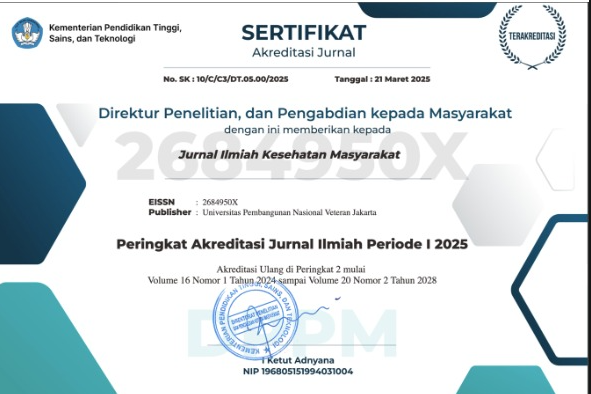Hubungan Antara Lingkungan Kerja Panas Dengan Keluhan Heat Related Illnes pada Pekerja Home Industry Tahu di Dukuh Janten, Bantul
Abstract
Latar Belakang : Dalam suatu lingkungan kerja, tenaga kerja akan menghadapi tekanan lingkungan kerja dan beban kerja utama yaitu tugas dalam melaksanaan pekerjaan sesuai dengan bagiannya dan terdapat pula faktor yang menyebabkan beban tambahan sehingga dapat menimbulkan gangguan bagi tenaga kerja. Faktor tersebut antara lain faktor fisik, faktor kimia, faktor biologis, faktor fisiologis, dan faktor mental psikologi. Tekanan panas merupakan salah satu faktor fisik yang dalam keadaan tertentu dapat menimbulkan gangguan. Gangguan akibat paparan panas antara lain adanya Heat stroke, Heat exhaustion, Heat Rush, Heat Cramps, Heat syncope, Heat Hyperventilation, Prickly Heat, miliria.
Metode : Jenis Penelitian kuantitatif dengan menggunakan metode Observasional analitik, dengan menggunakan pendekatan cross sectional. Sampel pada penelitian ini berjumlah 60 responden. Teknik pengambilan sampel dengan mengunakan simple random sampling dengan instrumen penelitian lembar observasi. Pengukuran lingkungan kerja panas dengan menggunakan Questtemp Heat Stress Monitor. Analisis data dengan menggunakan uji Chi-Square.
Hasil : Berdasarkan hasil analisis uji Chi-Square didapatkan hasil p-value 0,030, dan (CI 95% 1,008 – 3,275) artinya ada hubungan antara lingkungan kerja panas dengan keluhan Heat Related Illness (Heat Cramps, Heat Exhaustion, Dehidrasi)
Kesimpulan : ada hubungan antara lingkungan kerja panas dengan keluhan Heat Related Illness (Heat Cramps, Heat Exhaustion, Dehidrasi).
Kata Kunci : Lingkungan Kerja Panas, keluhan Heat Related Illnes, Pekerja
Relationship Between Hot Work Environment With Complaints of Heat Related Illnes (Heat Cramps, Heat Exhaustion, Dehydration) in Tofu Home Industry Workers in Janten Hamlet, Ngestiharjo Village, Kasihan, Bantul
Background : In a work environment, the workforce will face the pressure of the work environment and the main workload, namely the task of carrying out work in accordance with its part and there are also factors that cause additional burdens so that it can cause interference to the workforce. These factors include physical factors, chemical factors, biological factors, physiological factors, and mental psychology factors. Heat pressure is one physical factor that can cause interference in certain circumstances. These disorders include complaints such as heat exposure such as Heat stroke, Heat exhaustion, Heat Rush, Heat Cramps, Heat syncope, Hyperventilation Heat, Prickly Heat, Miliria.
Method : This type of quantitative research uses analytic observational methods, using a cross sectional approach. The sample in this study amounted to 60 respondents. The sampling technique using simple random sampling with the observation instrument observation sheet. Measurement of hot working environment by using Quest Heat Stress Monitor. Data analysis using the Chi-Square test.
Result : Based on the results of the Chi-Square test results obtained p-value 0.030, and (CI 95% 1.008 - 3.275) means that there is a relationship between the hot work environment with complaints of Heat Related Illness (Heat Cramps, Exhaustion Heat, Dehydration).
Conclusion : there is a relationship between the hot work environment with complaints of Heat Related Illness (Heat Cramps, Exhaustion Heat, Dehydration).
Keywords : Hot Work Environment, complaints of Heat Related Illnes.
References
Suma’mur. 2009. Higiene Perusahaan dan Kesehatan Kerja (Hiperkes). Jakarta: Sagung Seto.
Suma’mur P.K. 2014. Keselamatan Kerja Dalam Perspektif Hiperkes dan Keselamatan Kerja. Jakarta: Erlangga Medical Series.
Peraturan Menteri Tenaga Kerjaan dan Transmigrasi Republik Indonesia Nomor 05 tahun 2018 Tentang Keselamatan dan Kesehatan Kerja di Lingkungan Kerja.
Plog, B.A. dan Patricia J.Q. Fundamental of Industryal Hygiene (5th Ed). USA-NSC.
Saputri., dan Hendra. 2014. Analisis Pajanan Tekanan Panas dan Keluhan Subjektif pada Pekerja pada Bagian Produksi PT. Frisian Flag Plant Ciracas pada tahun 2014. Jurnal Kesehatan Masyarakat.
Pamungkas, T.R. 2013. Analisis Tekanan Panas dan Keluhan Subjektif Akibat Pajanan Tekanan Panas Pada Pekerja Di Area United Tractors Tbk Tahun 2013. Skripsi. Universitas Indonesia.
Maulidiani. A.F. 2013. Gambaran Keluhan Subyektif Akibat Tekanan Panas Diarea Peleburan, Proses Sekunder, dan Pengecoran Slap Steel Plan (SSP) PT. Krakatau Steel Cilegon, Banten Tahun 2012. Skripsi. Universitas Indonesia
Wulandari, J. 2017. Efek Iklim Kerja Panas Pada Respon Fisiologis pada Pekerja di Ruang Terbatas PT. Nippon Sokhubai Indonesia. Jurnal The Indonesian Jurnal of Occupational Safety and Health Vol.6, No.2.
Amaliya. 2018. Hubungan Tekanan Panas Terhadap Suhu Tubuh dan Denyut Nadi pada Masyarakat yang Bekerja Di Pelabuhan Tradisional Desa Eretan Wetan, Kecamatan KandangHaur, Indramayu. Jurnal Kesehatan Masyarakat. Vol.2, No.1
Cahyaningsih D.A. 2018. Keluhan Subyektif Akibat Paparan Panas pada Operator dan Pemeliharaan Boiler PT. IP Tahun 2018. Skripsi. Poltekes Kemenkes Surabaya
Ultani, J. 2011. Faktor Yang Berhubungan dengan Keluhan Akibat Tekanan Panas pada Karyawan Departement Process Plant (FURNACE) PT. INCO Sorowako, Makassar. Skripsi. Universitas Hasanudin.
Crandall C. G. 2005. Effects of Heat Stress on Thermoregulatory Responses in Congestive Heart Failure Patients. Volume 23
Direktorat Kesehatan Kerja RI. 2014. Pedoman Kebutuhan Cairan bagi Pekerja Agar tetap Sehat dan Produktif Edisi 1. Bekerjasam dengan Perhimpunan Spesialis Kedokteran Okupasi Indonesia.
Sekretariat Negara Republik Indonesia, Undang-Undang Republik Indonesia Nomor 13 tahun 2003 Tentang Ketenagakerjaan.
Almatsier, S. 2009. Prinsip Dasar Ilmu Gizi. Jakarta: Gramedia Pustaka Utama.









.jpg)








